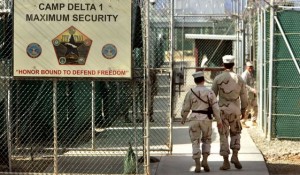Editor’s Note – Obama is making good on his promises from 2008 to close the Guantanamo Bay Detention Facility in furious fashion. With the loss of power in Congress, this may be one of many executive actions we will see take place as Obama’s second term enters the last two years.
Once again, as Senator Kelly Ayotte R-NH said: “The safety of Americans, not the fulfillment of a misguided campaign promise, should guide national security decisions.” Obama is placing America’s needs behind his own as we now see was always his driving motivation.
Similar to what he did with the ‘Taliban5,’ Congress again was ignored:
Despite fierce opposition in Congress to closing the detention facility, however, there is little that lawmakers can actually do to stop the president from continuing to release detainees.
On paper, Congress requires the administration to give 30 days’ advance notice before any transfer, but that was flouted in the case of the Taliban prisoners who were swapped for Bergdahl.
Despite the fact that 56% of Americans want the facility to stay open and the detainees to remain in custody, Obama is moving in ‘Overdrive.’.
Obama’s big push on Guantanamo
By Kristina Wong and Jesse Byrnes – The Hill
 President Obama’s push to close the Guantanamo Bay detention camp is going into overdrive, with more detainee transfers in the last two months of 2014 than in the previous three years combined.
President Obama’s push to close the Guantanamo Bay detention camp is going into overdrive, with more detainee transfers in the last two months of 2014 than in the previous three years combined.
Since the Nov. 4 elections, Obama has released 22 detainees, in sharp contrast to the period from 2011 to 2013 inclusive, when only 19 were released.
In the first six months of 2014, he had released only six detainees from the facility in Cuba — including the five members of the Taliban who were swapped for prisoner of war Sgt. Bowe Bergdahl.
With less than two years left in office, the president appears to be going full throttle, promising in a December interview on CNN “to do everything” he can to fulfill his 2008 campaign promise of shutting down Guantanamo, despite congressional opposition.
He released 44 people from the prison camp during his first full year in office in 2009, and 24 in 2010, but transfers then slowed to a trickle, largely due to opposition on Capitol Hill.
In 2011, there were only three transfers; in 2012, five; and in 2013, 11.
So far, Obama has released a total of 111 detainees while in office, according to a Defense official.
In total, of the 780 people detained at the facility, 643 have been transferred, and nine have died while in custody, according to analyses from The New York Times and NPR.
After the administration announced five more transfers on Wednesday, Sen. Kelly Ayotte (R-N.H.) said she was “deeply troubled by the administration’s continued transfer of dangerous terrorists from Guantanamo.”
“The United States must take every possible measure to prevent former detainees from returning to the battlefield,” she said in a statement Wednesday. “The safety of Americans, not the fulfillment of a misguided campaign promise, should guide national security decisions.”
Ayotte said that almost 30 percent of former Guantanamo detainees have reengaged or are suspected of reengaging in terrorism.
Those concerns are supported by some veterans of the Bush administration.
“The further you go into the pile of Gitmo detainees that are there now, the more dangerous they are,” said retired Navy Cmdr. J.D. Gordon, a former Pentagon spokesman during the Bush administration.
Gordon pointed to the Obama administration recently offering a reward for information on a detainee released from Guantanamo in 2006, who now allegedly serves as a top leader with Al Qaeda in the Arabian Peninsula.
“They just put out a $5 million dollar bounty. So that shows the folly of releasing guys that we were reasonably sure, or we think, may return to terrorism,” said Gordon, who is a senior fellow at the Center for a Secure Free Society.
Despite fierce opposition in Congress to closing the detention facility, however, there is little that lawmakers can actually do to stop the president from continuing to release detainees.
On paper, Congress requires the administration to give 30 days’ advance notice before any transfer, but that was flouted in the case of the Taliban prisoners who were swapped for Bergdahl.
 Lawmakers have also included restrictions in their annual defense policy and spending bills. For example, the $1.1 trillion funding bill passed by Congress in December bars the transfer or release of those held in Guantanamo to prisons in the United States.
Lawmakers have also included restrictions in their annual defense policy and spending bills. For example, the $1.1 trillion funding bill passed by Congress in December bars the transfer or release of those held in Guantanamo to prisons in the United States.
The president has said that under certain circumstances those restrictions could violate the “constitutional separation of powers” between the legislative and executive branches.
However, lawmakers who oppose closing the facility can lean on public support for their cause.
A Fox News poll released earlier this month found that a majority of Americans, 56 percent, want to keep Guantanamo open, compared to fewer than a third, 32 percent, who would prefer it to be closed, and its prisoners be transferred to U.S. facilities.
As part of the administration’s strategy to close the prison camp, officials have begun arguing that housing detainees at Guantanamo is too costly, and that they should instead be held at super-maximum-security prisons within the United States.
“The American people should not be spending hundreds of millions of dollars a year on a facility that harms our standing in the world, damages our relationships with key allies, and emboldens violent extremists. Closing the facility remains a top priority for the president,” said National Security Council spokesman Patrick Ventrell on Wednesday.
The total cost of detention operations at Guantanamo for fiscal 2014 was $397.4 million, according to Defense statistics. That would bring the average cost per detainee in 2014 to $2.8 million.
According to Politifact, costs at a high-security federal prison as of 2012 are about $34,000 per year per inmate.
Of the remaining 127 detainees left at Guantanamo Bay, 59 have been deemed eligible for transfer after a lengthy interagency review process. Fifty-two of those eligible for release are from Yemen.
However, their potential release is complicated by serious political instability in Yemen. The Yemeni government may not be able to ensure that those released will not return to the fight
Another 10 detainees are currently undergoing prosecution via military tribunal at Guantanamo.
Of the remaining 58, at least 23 are designated for prosecution. Six have been re-designated for transfer, but the other 29 either await a periodic review board or are ineligible for transfer.
The president is hoping to bring those prisoners to a super-maximum-security prison within the United States.
“It does not make sense for us to spend millions of dollars per individual, when we have a way of solving this problem that’s more consistent with our values,” Obama said on CNN.

